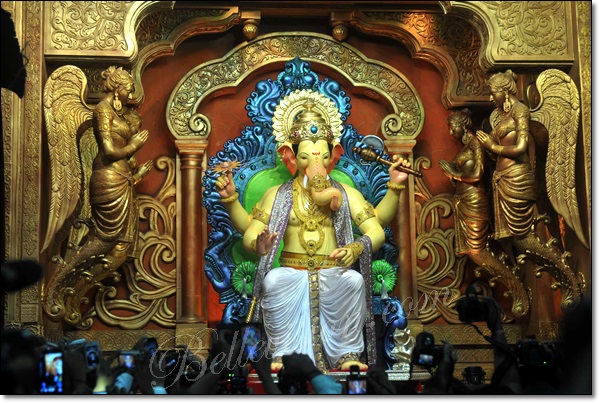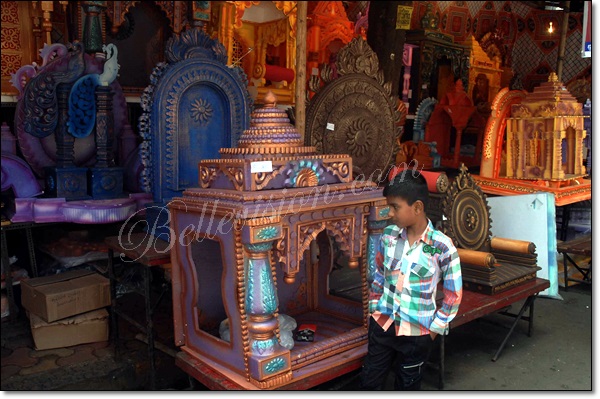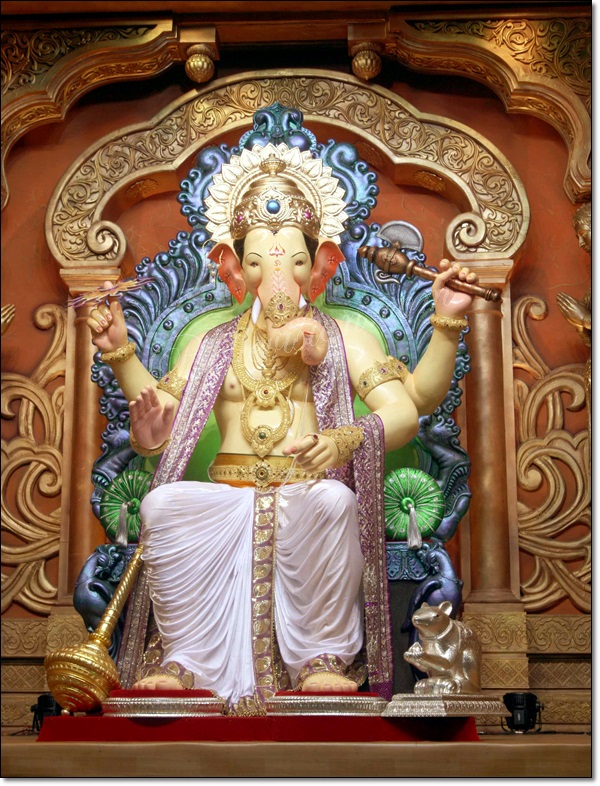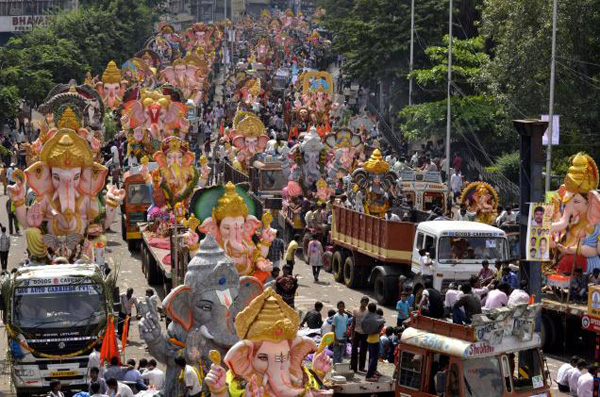Ganesh Chaturthi: Festival of the deity who promotes wisdom and prosperity
By Eugene DSouza, Moodubelle
Bellevision Media Network
09 Sep 2013: Ganesh Chaturthi is one of the important festivals in India that is being eagerly awaited and celebrated with great devotion and enthusiasm. This festival promotes family bond and public enthusiasm. This year Ganesh Chaturthi is being celebrated on September 11, which is Shukla Chaturthi of the Hindu month of Bhadra which generally falls between August and September. The duration of this festival varies from 1 day to 11 days, depending on the place and tradition.
Ganesh Chaturthi also known as Vinayaka Chaturthi is celebrated as the birthday of Lord Ganesh. Ganesh being the god of wisdom and prosperity is invoked before the beginning of any auspicious work by the Hindus. It is believed that for the fulfillment of one’s desires, his blessing is absolutely necessary. According to the mythology, he is the son of Shiva and Parvati, brother of Kartikeya - the general of the gods, Lakshmi - the goddess of wealth and Saraswati-the goddess of learning. There are numerous stories in Hindu mythology, associated with the birth of this elephant-headed god, whose vehicle is the rat and who loves Modaks. As per Hindu mythology Lord Ganesh is considered as “Vigana Harta” (one who removes obstacles) and “Buddhi Pradaayaka” (one who grants intelligence). This festival is very important for students, they worship Lord Ganesh to illumine their minds.

According to one of the legends, Parvati created Ganesh out of the sandalwood paste that she used for her bath and breathed life into him. Letting him stand guard at the door she went to have her bath. When her husband, Shiva returned, the child who had never seen him stopped him. In anger, Shiva severed the head of the child and entered his house. Parvati, learning that her son was dead was full of grief and asked Shiva to revive him. Shiva cut off the head of an elephant and fixed it on the body of Ganesh.
Another legend recounts the story that one day the gods decided to choose their leader and a race was held between the brothers- Kartikeya and Ganesh. The condition was that whoever took three rounds of the earth first would be made the Ganaadhipati or the leader. Kartikeya seated on a peacock as his vehicle, started off for the race. Ganesh was given a rat, which moved swiftly.
Ganesh realized that the test was not easy, but he would not disobey his father. He reverently paid respect to his parents and went around them three times and thus completed the test before Kartikeya. In justification of his act, Ganesh said that his parents pervade the whole universe and going around them was more than going round the earth. All the gods were pleasantly surprised to hear the logic of Ganesh and his intelligence and hence he came to be known as the Ganaadhipati or leader, now referred to as Ganapati.

Ganesh Chaturthi is said to have been celebrated since the days of Satavahana, Chalukya, Rashtrakuta and Maratha rulers. The festival is mainly celebrated in the states of Maharashtra, Tamil Nadu, Karnataka, Andhra Pradesh and even in other states with a lot of zeal and splendour.
Ganesh Chaturthi is the most popular festival of Maharashtra. It was started by Chatrapati Shivaji as a public event to promote traditions and nationalism. This festival was even celebrated by Peshwas to worship Ganapati as their family deity.
The festivities remained a family affair until the festival was revitalized by Bal Gangadhar Tilak, one of the prominent national leaders during the freedom struggle in the late 19th Century, to take the message of freedom struggle to all Indians. This festival brought in a feeling of unity and togetherness among Indians that helped in revival of their patriotic spirit. Through the medium of this festival Tilak brought together all the classes of the society against British rule. He stressed that Ganesh Chaturthi was a festival for everyone irrespective of the caste or class, and so he organized cultural events like dance dramas, musical nights, and religious gatherings on this festival. That was the time when social and political gatherings were prohibited by the British. Festivals like Ganesh Chaturthi that continued for ten days gave people of every religion the scope to interact and know each other. It is from that time this festival has been celebrated every year with great fervour all over the country.

Ganesh Chaturthi is being celebrated at two levels, family and public (Sarvajanik). Many families have been celebrating Ganesh Chaturthi as family tradition. Prior to the festival, the families clean their homes and prepare sweets, especially ‘modhak’ considered to be favourite sweet of Ganesh. On the day of the festival, they bring Ganesh idol, the size of which depends on the budget of each family. They invite their family members, relatives and neighbours to pay a visit to their homes during the days that they keep the idol in their home. This is the occasion when family members and relatives who work and reside in other cities make it a point to visit their ancestral homes in their respective native places. This tradition is very much prevalent in the Konkan region. In this way, Ganesh Chaturthi festival fosters family bond and human interaction.
Since Balagangadhar Tilak started organizing public celebration of Ganesh Utsav in 1895 to promote national and patriotic sentiments, sarvajanik celebration of the festival has taken up the form of a tradition that is being followed in Maharshtra and other states in general and in Mumbai and its suburbs in particular. There are thousands of Sarvajanik Ganesh Utsav Mandals who collect contributions from the shop keepers and public and put up large pandals and install quite large idols of Ganesh depending on the budget of the mandal and decorate and illuminate the pandals. They also collect sponsorship and display banners of companies and business interests. Hence, commercialization has taken over the celebration of Ganesh Chaturthi. Many of the Sarvajanki Mandals take up themes of contemporary importance such as environmental concern, illiteracy, corruption and even historical events and put up exhibitions and arrange speeches and discussions by knowledgeable persons.
The 11 days long Ganesh festival is the time for outing to many people in Mumbai. Many families make it a point to visit some of the large Ganesh pandals in South Mumbai such as Parel, Lalbaug, Dadar and other areas to view the huge Ganesh idols in various poses and attires, decoration and exhibition associated with the theme of the respective Ganesh pandals. Many Ganesh Mandals organize musical concerts both classical and modern. Since quite a number of years it has been a practice among certain affluent Ganesh Mandals to invite professional singers and film stars to attract and entertain the devotees.

’Lalbaugcha Raja’ is one of most popular public Ganesh idols in Mumbai and is organized by Lalbaugcha Raja Sarvajanik Ganeshotsav Mandal. The Mandal, formerly known as Sarvajanik Ganeshotsav Mandal, Lalbaug was founded in 1934 at Lalbaug. The idol is kept for public display for 11 days and thereafter it is immersed on the auspicious day of Anant Chaturdashi. Lalbaugcha Raja Mumbai location is the focal point for all devotees of the Lord Ganesha who come from all over Mumbai, India and even abroad to give their offerings and praises.
There is a curious background to the foundation of the Mandal in 1934. The fishermen and vendors who did not have a place to sell their goods as the market place at Peru Chawl was shut down in 1932 expressed a vow (Navas) to Ganesh. With the efforts of the then local Councilor Kuwarji Jethabhai Shah and many other beneficiaries the landlord Rajabai Tayyabali agreed to give a plot for construction of a market. As fulfillment of their wish, the fisherman and the traders established the Ganesh Idol on 12 September 1934.
From that day onwards, this Lord Ganesh has become popular as he fulfills the wishes (Navas) of devotees. The first idol was dressed in the customary fashion of fisherman. During "Quit India" movement years, the Ganesh idol was shown in the get-ups of different freedom fighters. In 1946, it was depicted as Netaji Subhash Chandra Bose. In 1947, to celebrate Independence, the Ganesh idol was in Pandit Jawaharlal Nehru’s get-up riding a bullock-cart. In 1948, after assassination of Mahatma Gandhi, the Ganesh idol was his look-alike.
Every year the Mandal receives donations worth billions in the form money, gold, silver and other precious items. All the jewellery items are auctioned off and the proceeds are used for various charitable causes.
Every year, the various Ganeshotsav Mandals try to bring in some kind of novelty in order to attract devotees. Different types of materials are being used to put up the idol. Artists devise various poses and create meaningful environment to place the idol. As the idols are immersed in water bodies there has been the danger of water pollution due to the plaster of Paris, the usual material to prepare the idol and synthetic colour. Since few years an awareness is being spread to prepare idols by using non-pollutant materials such as paper pulp and other bio-degradable substances and natural plant colours. There has been favourable response and eco-friendly Ganesh idols are being installed in many sarvajanik pandals.

At the end of the festival, on 11th day most of the Sarvajanik Ganesh idols immersed in various water bodies such as sea, lakes or wells. In South Mumbai, Chowpatty is the destination for the immersion of most of the idols. The processions accompanied with loud music and devotees dancing in front of the floats carrying the idols start by noon and slowly make their way through the streets and roads of Mumbai with elaborate security arrangements by the police. Traffic practically comes to a halt in the areas through which the processions pass. Thousands of people line up the roads or even occupy strategic spots on top of building terraces to view the magnificent procession. Many foreign tourists also make it a point to visit Mumbai during this occasion.
| Comments on this Article | |
| Lakshmi, Mangalore | Tue, September-10-2013, 12:15 |
| Excellent Photography Nd beautiful | |
| Benedict Noronha, Udupi | Mon, September-9-2013, 1:45 |
| I wish all the viewers of Belle vision a happy feast of Ganesha, a deity of wisdom and protector of all obstacles. May the God bless every one according to their belief. Dr Eugene has made great efforts in narrating at length about the deity. May his works also be blessed. Benedict Noronha, Advcate Udupi. | |
| Alphonse Mendonsa, Pangla/Abu Dhabi | Sun, September-8-2013, 10:36 |
| Dear Sir Eugene, Thanks for wonderfully narrated complete history of Lord Ganesha and benefits reaped thourgh His Intercessions. Wishing all our Hindu brothern a very Happy Ganesh Chaturthi festival. | |




 Write Comment
Write Comment E-Mail To a Friend
E-Mail To a Friend Facebook
Facebook Twitter
Twitter  Print
Print 














